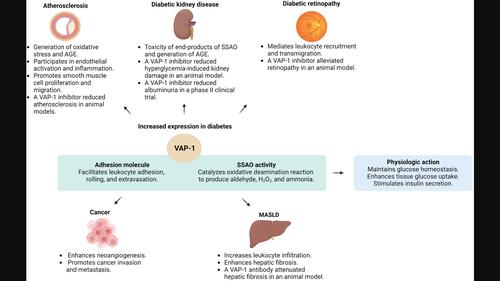当前位置:
X-MOL 学术
›
J. Diabetes Investig.
›
论文详情
Our official English website, www.x-mol.net, welcomes your feedback! (Note: you will need to create a separate account there.)
The role of vascular adhesion protein‐1 in diabetes and diabetic complications
Journal of Diabetes Investigation ( IF 3.2 ) Pub Date : 2024-04-06 , DOI: 10.1111/jdi.14209 I‐Weng Yen, Hung‐Yuan Li
Journal of Diabetes Investigation ( IF 3.2 ) Pub Date : 2024-04-06 , DOI: 10.1111/jdi.14209 I‐Weng Yen, Hung‐Yuan Li

|
Vascular adhesion protein‐1 (VAP‐1) plays a dual role with its adhesive and enzymatic properties, facilitating leukocyte migration to sites of inflammation and catalyzing the breakdown of primary amines into harmful by‐products, which are linked to diabetic complications. Present in various tissues, VAP‐1 also circulates in a soluble form in the bloodstream. Diabetes is associated with several complications such as cardiovascular disease, retinopathy, nephropathy, and neuropathy, significantly contributing to disability and mortality. These complications arise from hyperglycemia‐induced oxidative stress, inflammation, and the formation of advanced glycation end‐products (AGEs). Earlier research, including our own from the 1990s and early 2000s, has underscored the critical role of VAP‐1 in these pathological processes, prompting extensive investigation into its contribution to diabetic complications. In this review, we examine the involvement of VAP‐1 in diabetes and its complications, alongside its link to other conditions related to diabetes, such as cancer and metabolic dysfunction‐associated fatty liver disease. We also explore the utility of soluble VAP‐1 as a biomarker for diabetes, its complications, and other related conditions. Since the inhibition of VAP‐1 to treat diabetic complications is a novel and promising treatment option, further studies are needed to translate the beneficial effect of VAP‐1 inhibitors observed in animal studies to clinical trials recruiting human subjects. Besides, future studies should focus on using serum sVAP‐1 levels for risk assessment in diabetic patients, identifying those who need intensive glycemic control, and determining the patient population that would benefit most from VAP‐1 inhibitor therapies.
中文翻译:

血管粘附蛋白-1在糖尿病及糖尿病并发症中的作用
血管粘附蛋白-1 (VAP-1) 以其粘附和酶特性发挥双重作用,促进白细胞迁移到炎症部位,并催化伯胺分解成有害副产物,这些副产物与糖尿病并发症有关。 VAP-1 存在于各种组织中,也以可溶形式在血液中循环。糖尿病与多种并发症有关,如心血管疾病、视网膜病变、肾病和神经病变,显着导致残疾和死亡。这些并发症是由高血糖引起的氧化应激、炎症和晚期糖基化终产物(AGE)的形成引起的。早期的研究,包括我们在 2000 年代初和 20 世纪 90 年代的研究,强调了 VAP-1 在这些病理过程中的关键作用,促使人们对其对糖尿病并发症的影响进行广泛的研究。在这篇综述中,我们研究了 VAP-1 在糖尿病及其并发症中的参与,以及它与其他糖尿病相关疾病的联系,例如癌症和代谢功能障碍相关的脂肪肝疾病。我们还探讨了可溶性 VAP-1 作为糖尿病、其并发症和其他相关疾病的生物标志物的用途。由于抑制 VAP-1 治疗糖尿病并发症是一种新颖且有前途的治疗选择,因此需要进一步研究将动物研究中观察到的 VAP-1 抑制剂的有益效果转化为招募人类受试者的临床试验。此外,未来的研究应侧重于利用血清 sVAP-1 水平对糖尿病患者进行风险评估,识别需要强化血糖控制的患者,并确定最能从 VAP-1 抑制剂治疗中受益的患者群体。
更新日期:2024-04-06
中文翻译:

血管粘附蛋白-1在糖尿病及糖尿病并发症中的作用
血管粘附蛋白-1 (VAP-1) 以其粘附和酶特性发挥双重作用,促进白细胞迁移到炎症部位,并催化伯胺分解成有害副产物,这些副产物与糖尿病并发症有关。 VAP-1 存在于各种组织中,也以可溶形式在血液中循环。糖尿病与多种并发症有关,如心血管疾病、视网膜病变、肾病和神经病变,显着导致残疾和死亡。这些并发症是由高血糖引起的氧化应激、炎症和晚期糖基化终产物(AGE)的形成引起的。早期的研究,包括我们在 2000 年代初和 20 世纪 90 年代的研究,强调了 VAP-1 在这些病理过程中的关键作用,促使人们对其对糖尿病并发症的影响进行广泛的研究。在这篇综述中,我们研究了 VAP-1 在糖尿病及其并发症中的参与,以及它与其他糖尿病相关疾病的联系,例如癌症和代谢功能障碍相关的脂肪肝疾病。我们还探讨了可溶性 VAP-1 作为糖尿病、其并发症和其他相关疾病的生物标志物的用途。由于抑制 VAP-1 治疗糖尿病并发症是一种新颖且有前途的治疗选择,因此需要进一步研究将动物研究中观察到的 VAP-1 抑制剂的有益效果转化为招募人类受试者的临床试验。此外,未来的研究应侧重于利用血清 sVAP-1 水平对糖尿病患者进行风险评估,识别需要强化血糖控制的患者,并确定最能从 VAP-1 抑制剂治疗中受益的患者群体。



























 京公网安备 11010802027423号
京公网安备 11010802027423号